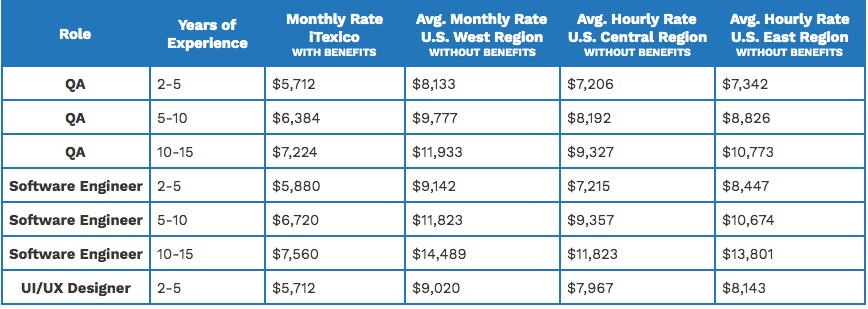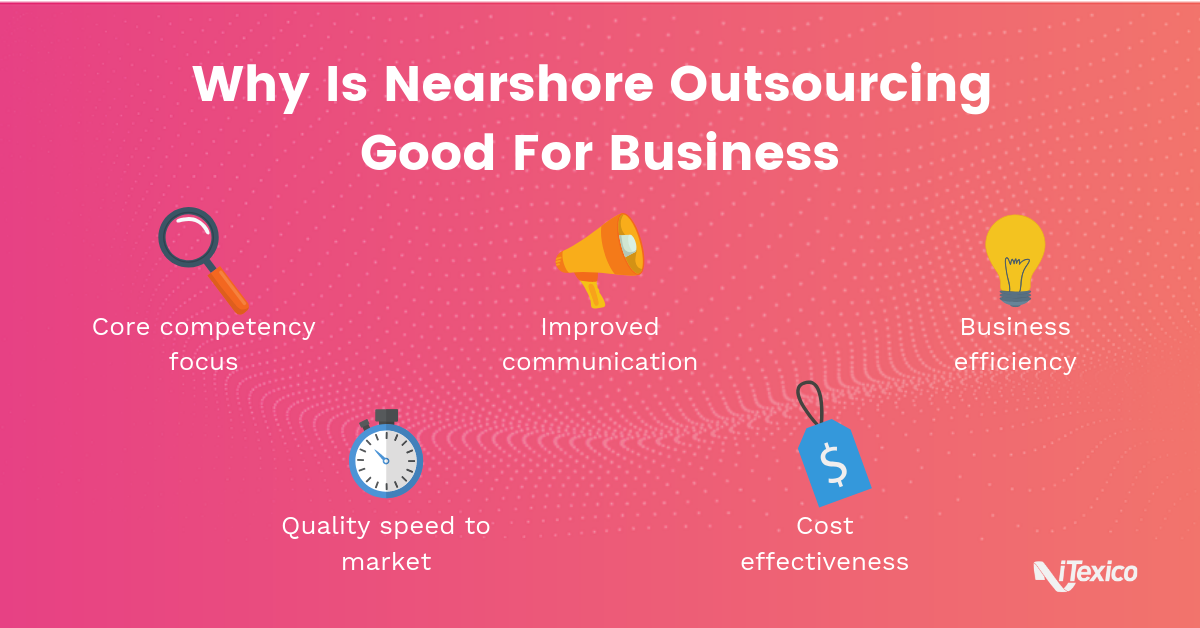Nearshore Outsourcing: Why Is Outsourcing Good For Business?
Being the playmaker for a company is no easy feat. Your plate tends to pile up quick between your work, responsibilities, and stress eating up the few free spaces you have. You, of course, saw this coming; you knew what you signed up for. A company is nothing more than a great machine, and all the employees of that company are the engineers tending to it, keeping it running.
Just keeping the machine running, however, shouldn’t be your end goal. Keeping the machine running alone means stagnation, stillwater, no progression. Doing nothing more than keeping your head above water lacks ambition. You should always be trying to move onwards and upwards.
Outsourcing your work may be the next rung on the ladder for your next company. Progressing toward a better, more efficient organization spells a brighter future for everyone taking care of the machine, all while lightening the load off your shoulders. We aim to inform you why outsourcing is good for business, and by the end of this article we hope you may feel the urge to pursue a new course of action.
Reputation or no, outsourcing, specifically the nearshore variety, is well within the best interests for everyone.
Why Is Outsourcing Good For Business?
We won’t keep you waiting on the burning question: why is outsourcing good? There’s more than one answer to that, as all good responses should have. In a nutshell, outsourcing is a good idea because you’re able to draw on a diverse labor pool with access to skills that would be difficult and time-consuming to develop internally in a cost-effective method.
Developing a competent group of skilled individuals isn’t a task completed in a day. Anything done well takes time, effort, and money before it becomes an asset to your project. That being said, the resources being funneled into preparing a certain skillset for a project means a sizeable amount of expenses that could be put to better use.
That’s not even mentioning the possibility of needing to sift through the workforce and recruit new manpower to contribute to the work. Combining the possibility of taking on new blood with the resources necessitated for bringing everyone involved to a satisfying competency level represents a significant drain on the company.
In the wake of staring down the list of what you’ll need to get your project moving, it’s time to consider alternatives to an internal workforce.
Outsourcing your work provides a solution toward avoiding the dreaded recruitment and training process. Internal development can end up wasting your time and money on new-hires who may not pan out as lucratively as you’d hope. Outsourcing work through a nearshore company affords you a variety of benefits.
- Skilled, reputable workers
- Core competency focus
- Improved communication
- Efficiency
- Speed
- Cost effectiveness
1. Core Competency Focus
Without the need of worrying about cobbling together a high-quality team of professionals, your company can afford to shift its focus toward other pressing matters. Leave the care of this project in an outsourced team’s hands and your undivided attention can be turned toward your business’ core competencies.
Proper delegation of responsibilities leads toward more production at a consistently high-quality. While done internally alone, you may find that your resources get strained from handling so many projects. However, delegation via nearshore company neutralizes the potential strain that could otherwise lead to low-quality products and high-stress environments. Outsourcing is as good for your employees as it is for your business.
2. Improved Communication
Admittedly, the benefit of improved communication is mostly a differentiation between nearshore and offshore outsourcing. Think of it this way - if you hire a company in Saudi Arabia do work on your projects, when are you going to communicate with them? At night, early morning? Those are terrible, awkward hours and email doesn’t provide the necessary speed of communication.
A nearshore company means someone in your timezone, working during your business hours. That level of communication alone is valuable enough to put a nearshore company above an offshore one.
3. Efficiency
The care afforded to your newfound focus on important business matters is just one example of the efficiency that outsourcing affords you. With the outsourced work handled, work hours become more flexible as less work is piled on everyone’s plates. With work effectively delegated, company expansion can proceed more smoothly. You can get the best of both worlds: high quality work output and personal attention from project leaders on other projects.
4. Speed
With increased efficiency and the sole focus of a company on a singular project, you can also expect your time frame to be moved up. The more projects you take on internally, the slower your overall production will fare for the sake of quantity and quality. Chances are you can see why outsourcing your work tends to result in quicker results and higher quality delivery on completion.
5. Cost Effectiveness
Out of all of the reasons why outsourcing is good, cost effectiveness stands out above the rest. Every company’s unofficial motto follows the same line of logic: lower cost, higher quality. The less expenses you have to commit to projects without compromising their integrity means another dollar in the bank. As good as your own internal teams may be, outsourcing remains the more cost efficient outcome. Explore the differences between Onshore and
Nearshore and how the costs of building a Nearshore team with iTexico compares to local software development teams' fees in the U.S.
Outsourcing Is Cost Efficient
Nearshore VS Onshore Fees
Comparative table for rates with iTexico (fully burdened) and average rates in three different U.S. regions (without benefits).

Source: Salary.com
Arguing for the overall cost efficiency of outsourcing is a little more complicated than stating how much more quickly you can get work done. However, the facts stand by that outsourcing your work to a nearshore company saves money without compromising the overall quality of the project. There’s not a whole lot more you can ask for than that.
There’s a catch though. While nearshore companies are a worthwhile investment, chances are you won’t find what you’re hoping for cost-wise in the U.S. Technology has become the world’s driving force in every sector, making it a highly profitable field. However, due to the increase in emerging software companies, as well as a higher demand for high quality development resources, outsourcing in America is nowhere near as feasible as it used to be.
The demand has outpaced the supply, ergo the prices of local nearshore companies have too expensive to justify reasonable cost efficiency. If you were planning on going local for your outsourcing needs, be warned that the average cost of software development in the U.S. rounds out to about $100-$200 per hour. That usually winds up running up an expense between $7,000 and $150,000 to finish up a project.
American made, yes, but it’s a sizable wad of bills out of your wallet to afford the work. Not exactly living up to the company motto.
Rather than racking up a huge expense, you may need to turn your attention to your neighbor's yard. Mexico borders the U.S. and maintains the same time zones, making it place for outsourcing. By using one of their nearshore companies, you can find that what you would have paid for the same high-quality work in the U.S. costs half as much.
So why is outsourcing cheaper if done through Mexico? For starters, they’re able to draw from an enormous labor pool of technologically skilled talent to suit your needs. Since supply can match the demand, the competition drives prices down to secure contracts, not to mention the lower costs of living compared to America.
If you’re still concerned about your project falling shy of U.S. standards, you can rest easy. All digital products in Mexico fall under the USMCA agreement, guaranteeing strong IP protection, simplified visa procedures, and no tariffs or barriers on digital products. Essentially, the USMCA creates a framework that keeps your IP protected while simultaneously aligning Canadian, Mexican, and American digital product standards.
Service Tiers
Lauding the benefits of nearshore outsourcing is good, but it may be hard to visualize in the grand scheme of software development without knowing how it stacks up against its competition. Sourcing your projects can come in several different tiers, each with their own pros and cons that depend on what you’re looking for.
Source: FullStack Labs
Enterprise Class
“Enterprise Class” is a tier of custom software development companies that cater exclusively to companies that have the money to burn. They have a huge labor pool to effectively pull from and they’re almost guaranteed to get any customer software job completed. However, though they charge between $200,000 and $100,000,000+ for their projects, they’re not guaranteed to deliver a high-quality product.
A Minimal Viable Product - or MVP - is a method of development that creates a product with enough features to satisfy early customers while remaining open to feedback and change. It’s a way of beta-testing that encourages companies to adjust the product to fix flaws and appeal to the customers usability before finalizing projects.
Enterprise level consultancies tend to custom-create their projects without going through the MVP first. It’s risky, and although the final product may end up being an excellent tool, it can also fall short of expectations and be difficult to change. While a risky method, the Enterprise Class tier remains an appealing choice for original work designed for powerhouse corporations.
Big Business Class
While not too dissimilar to enterprise class consultancies, “Big Business Class” doesn’t appeal to Fortune 500 companies exclusively. They still deal with large companies, but none of them have the same purchasing power as the ones who deal with Enterprise level organizations.
Nonetheless, large businesses still pack the spending power to work on expensive projects that range between $125,000 and $1,000,000+, commanding an hourly rate of $200 to $300. This option is still out of the budget range of many businesses, but for those who fit the bill they still provide quality products.
Mid-Market Class
Without going for nearshore outsourcing, a “Mid-Market Class” organization tend to provide the best balance between cost and quality. While they tend to maintain a decent history of successful products, their smaller size means you may have to do more research to determine whether they’re the right fit for you.
A larger-sized company means they have more employees with a wider field of knowledge. The smaller the labor pool, the more likely it is that you may be pitching a project that they may not have as much experience with. Make sure to double-check your references with them before coming to an agreement.
Small Class
With a labor pool that generally consists of between five or ten employees, a “Small Class” organization tends to focus on a specific area of expertise. If you happen to have a project that will fit right up their alley, then you may find yourself with a great deal.
However, if you feel like your project may be too big for them to handle, reconsider whether you should make an arrangement with them. If they find themselves in way over their head, the resulting project will suffer for it. Again, it comes down to checking references and referring to their financial history to make sure they won’t go out of business in the middle of your project.
Freelance Developers
You may have projects that you simply don’t need an entire team for. Hiring on a freelancer to finish the work for you may turn out the be the best possible option in this case. They tend to be affordable, effective workers, but tend to carry risks like project dropping, disappearing with the code, and unequal focus on core skills. However, there are plenty of freelancers in the sea, meaning you’ll have no shortage of potential talent to pull from.
Offshore Developers
We’ve already gone into some length about offshore development. While outsourcing your work overseas may save you some cash, communication and quality tend to be the price for fast, cheap work. If you’re dead set on going offshore for your work, make sure there’s an established U.S. project management presence to be confident that you’ll be getting the high-quality work you’re paying for.
Nearshore Developers
We’ve gone into plenty enough depth on why outsourcing to nearshore developers is the best option for you. Hiring a nearshore company means not having to worry about training and recruiting expenses, a process that’s more of a thorn in the side than anything else. Judging the quality of a nearshore company can be based entirely on previous projects or, if you’re using a company like iTexico, you can rely on their talent acquisition and staffing processes.
Working with nearshore talent can lead toward quicker turnaround on completed projects without compromising quality. Nearshore companies hire talent that are experts in their industry, competent in delivering on-time, high-quality projects without charging an exorbitant price.
Conclusion
Why is outsourcing good for business? If we haven’t hammered it into your brains enough already, let’s do a quick recap. Nearshore outsourcing is the most cost efficient solution toward completing your projects. While they’re focused on completing a high-quality, quick turnaround product, you can refocus your company on your core competencies without worrying about the integrity of your projects. Low cost, high quality in a phrase or two.
If you’re going to take anything away, it’s that finding reliable outside help to cooperatively work with towards a greater goal opens the door for expansion and profit. High-quality products shouldn’t have to come at great prices. With a little consideration and help from iTexico in finding the perfect team in Mexican IT to suit your needs, you should be able to find a team that can handle anything thrown their way.





Post Your Comment Here